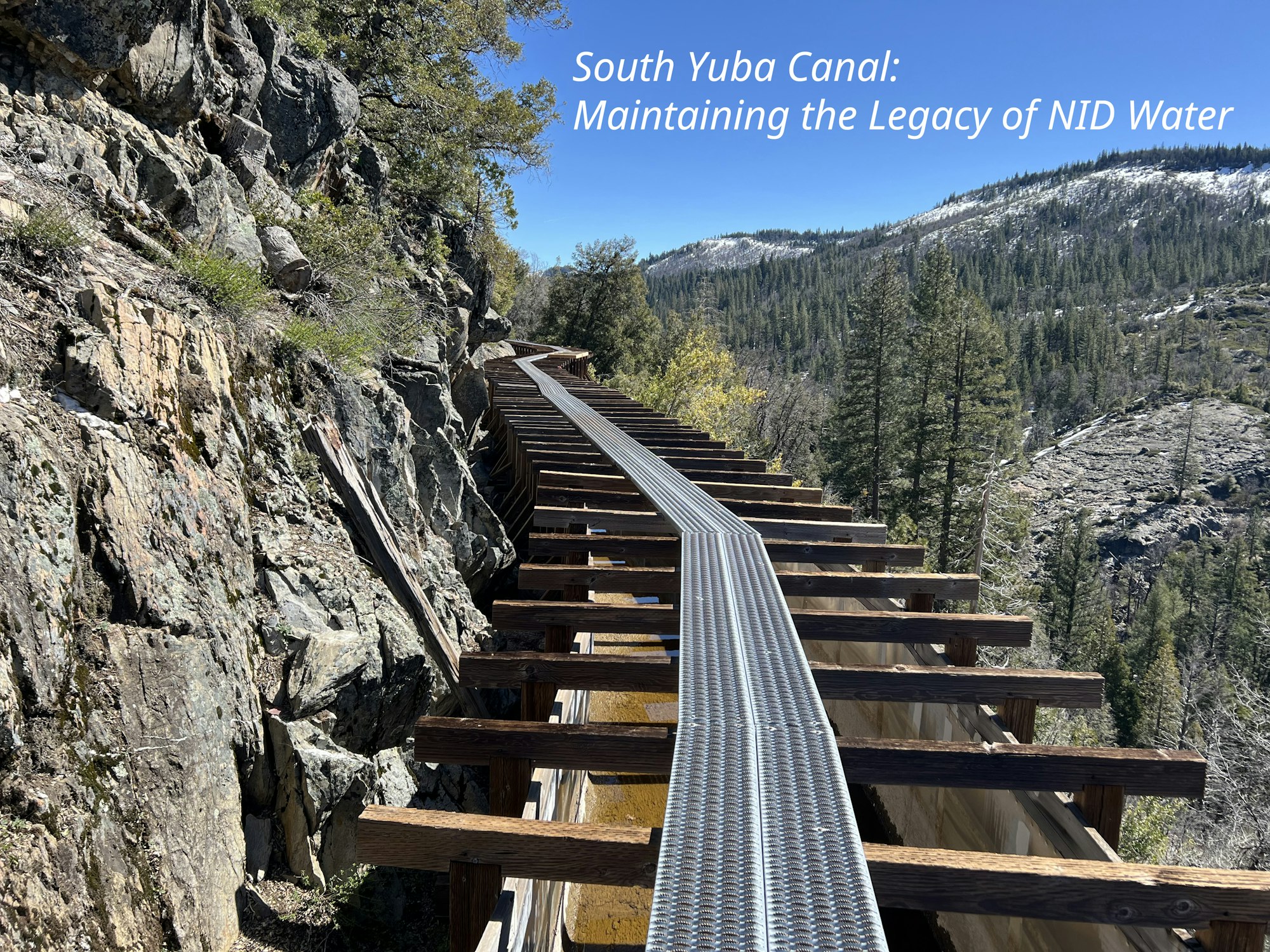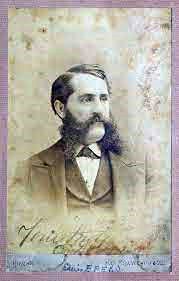NID Feature Story: Our Community Dependence on the South Yuba Canal
This Gold Rush canal, from the headwaters in the Sierra Nevada, is the lifeblood of local communities, agriculture

Precariously perched on the side of a mountain and blasted through granite tunnels, NID’s South Yuba Canal conveys precious snowmelt runoff from the upper reaches of the Sierra crest to the communities of Nevada County. The Nevada Irrigation District (NID) purchased this 17-mile stretch of flume and tunnel from Pacific Gas & Electric (PG&E) for $1. In 2023, the multi-year-long ownership transfer finally occurred.
Due to its remote location, vulnerability to severe damage, and its necessity for water delivery to Scotts Flat Reservoir, NID now dictates its own fate through prioritized maintenance and repair analysis. The significance of the delivery of water to our foothill community through this conduit cannot be overstated.
The South Yuba Canal is NID’s primary water conveyance to customers of western Nevada County, both treated and raw. Part wooden flume, part canal and tunnels, this vital infrastructure dates back to the California Gold Rush era. Today, its flows ensure Nevada County has irrigation water for local farms and fields, has treated water for household taps, keeps Scotts Flat Reservoir open for recreation, provides flows to generate hydroelectricity, and supplies our local Grass Valley Air Attack Base with water resources necessary in fighting wildfires from the air. The canal is also the primary conveyance to supply water to the cities of Grass Valley and Nevada City.
In total, it is part of the Deer Creek system that provides irrigation water to more than 3,300 customers and drinking water to another 18,260 customers.
In November 2023, the transfer of PG&E’s Deer Creek hydroelectric development to NID was complete, including the 17-mile portion of the South Yuba Canal below Bear Valley, the Chalk Bluff Canal, Deer Creek Powerhouse, and associated facilities. Of all the acquisition components, the preeminent infrastructure was the South Yuba Canal and the Deer Creek Powerhouse.
The canal flows through the Sierra

The South Yuba Canal moves water from the mountain headwaters of the Middle and South Yuba Rivers – from the Jackson Meadows, Bowman and Spaulding area –to Scotts Flat Reservoir. In total, the canal is about 17 miles long and traverses both private and public lands. Nearly 12 miles of the system are located within the Yuba River Ranger District of the Tahoe National Forest.
“The South Yuba Canal is the lifeblood of Nevada County,” said NID General Manager Jennifer Hanson. “It is the district’s critical water delivery system from the source headwaters high in the Sierra Nevada.”
There is history here. The canal, built from 1854-1858 by the South Yuba Mining and Canal Company, delivered endless flows to be used downhill in hydraulic mining and put Nevada County on the map. The water fueled high-pressure water cannons that blasted the mountainsides and dispersed rocks weighted with gold.

The canal traverses “some of the most rugged terrain you are goi ng to find in the Sierra,” according to Chip Close, NID Director of Operations.
For example, the construction of a waterway path along the side of a granite mountain was completed by men hanging over ledges in slings to drill and blast for anchors.
Recently, NID crews spent two weeks to repair and reinforce portions of the canal. A helicopter flew in and dropped beams and girders to workers positioned on a narrow walkway atop the flume and canal.

NID purchases the infrastructure for $1
Sometime circa 2013, PG&E indicated that the South Yuba Canal and the other Deer Creek facilities no longer served its operations. NID, understanding the dependence of its infrastructure to the canal, needed to be first in line to purchase it.
Talks of purchase heated up in November of 2018, when the NID Board of Directors approved a resolution authorizing the purchase of the Deer Creek facilities. Since then, the Federal Energy Regulatory Commission (FERC) and the California Public Utilities Commission (CPUC) have approved the transfer.
Not lost in the Board’s analysis of acquisition were the long-term costs. The acquisition came with ongoing capital, maintenance and operations expenses associated with the aged infrastructure and the maintenance costs due to the precarious and remote location of the canal.
“Yes, the transfer of 17 miles of the canal was done for $1. But there is so much more to it; NID is now responsible for assuming all costs of long-term improvements, operations, and maintenance. We knew what we were getting into, and securing our local hands-on oversight of the system is worth the cost to ensure our community enjoys the reliable water supply it has come to expect,” said Hanson.
The recent failure of PG&E’s portion of the canal
PG&E retained ownership and control of the upper approximate 1-mile canal segment stemming from Lake Spaulding. It is this segment that recently has suffered extensive damage. In this section, the canal is actually a pipe that was destroyed by a landslide in early February 2024.
This collapse rendered the South Yuba Canal inoperable; no water can pass down from the upper-elevation snowpack through Lake Spaulding to NID’s portion of the canal downstream.
The work to complete the broken pipe repair remains elusive, due to weather, topographical safety conditions and availability of pipe material.
The repair situation will impact deliveries to all NID customers, including raw water and treated water customers in Nevada County. It will also have severe effects on lake levels and recreation opportunities this summer on Scotts Flat. Also, hydroelectric generation will be affected by the water restrictions.
Scotts Flat is currently near full capacity, however that supply will begin to be tapped for raw water customers beginning on April 15, the start of irrigation season. Current projections from PG&E indicate that partial repairs could be complete and partial water deliveries through the canal will begin to replenish Scotts Flat sometime in mid-June.
However, General Manager Hanson says, “It is imperative that the partial flows are established by June 12. Otherwise, the District is at significant risk of running out of water for both treated water and agricultural uses. Facing a significant water shortage will cause hundreds of millions of dollars’ worth of damage to the communities we serve.”
For updates about the situation, NID has established a dedicated webpage. Click here.

History books have been written about the canal
The South Yuba Canal, built from 1854-1858, was the first major water project built in California. The original 16-mile canal channeled water tapped in the high Sierra to lower elevations, where it was used to power high-pressured water cannons used in hydraulic mining. The waterway featured nine miles of ditch, seven miles of flumes, and two tunnels that stretched more than two miles. Construction took four years with a total cost around $600,000.

Workers faced constant challenges. Not in the least was the construction of a mile-long flume that was more than 100 feet high on a narrow shelf of a granite mountain. It was so steep that the drilling and blasting was done by men hanging over ledges on ropes.
“ … the waters enter a flume, seven miles in length, set on solid wall-rock for one and a half miles through the canon [sic] on the South Yuba, a shelf having been blasted through the solid precipice rock, in places a hundred feet high, to receive it, the workmen at first being let down from the top by means of ropes to begin the drilling and blasting,” wrote Edwin Bean in Bean’s History And Directory Of Nevada County, California, published in 1867.
Onward we go
The South Yuba Canal will remain a topic of consternation as well as an engineering marvel due to its importance to convey snowmelt from the high Sierra to the foothills. NID is dedicated to maintaining and upgrading this historic canal, as it is the primary source of conveyance of water to Nevada County.
The Nevada Irrigation District was founded in 1921 upon a vote of the people to deliver water from the Sierra headwaters to enable the local foothill communities to thrive. Water has been the reason the region has developed to be one of the finest, most productive in the state.
“The district continues to build on many years of experience providing high-quality water, power, and recreation services. We are committed to continuing its legacy and remain dedicated to our community,” Hanson said.
(Published by Yubanet, April 2024)
